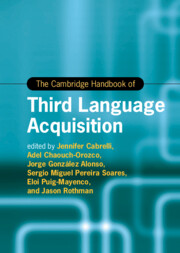Book contents
- The Cambridge Handbook of Third Language Acquisition
- Cambridge Handbooks in Language and Linguistics
- The Cambridge Handbook of Third Language Acquisition
- Copyright page
- Contents
- Figures
- Tables
- Contributors
- Introduction Multilingualism
- Part I Theoretical Approaches to L3/Ln
- Part II L3/Ln across Linguistic Domains
- Part III Becoming and Staying Multilingual at Different Ages
- Part IV L3/Ln in Action
- Part V L3/Ln and Cognition
- Part VI Research Methods in L3/Ln
- 25 Innovations and Challenges in Acquisition and Processing Methodologies for L3/Ln
- 26 Corpus Research
- 27 Case Study Research in Multilingual Contexts
- 28 Using Artificial Languages to Study Third Language Learning and Processing
- 29 Statistical Modeling in L3/Ln Acquisition
- Index
- References
29 - Statistical Modeling in L3/Ln Acquisition
from Part VI - Research Methods in L3/Ln
Published online by Cambridge University Press: 13 July 2023
- The Cambridge Handbook of Third Language Acquisition
- Cambridge Handbooks in Language and Linguistics
- The Cambridge Handbook of Third Language Acquisition
- Copyright page
- Contents
- Figures
- Tables
- Contributors
- Introduction Multilingualism
- Part I Theoretical Approaches to L3/Ln
- Part II L3/Ln across Linguistic Domains
- Part III Becoming and Staying Multilingual at Different Ages
- Part IV L3/Ln in Action
- Part V L3/Ln and Cognition
- Part VI Research Methods in L3/Ln
- 25 Innovations and Challenges in Acquisition and Processing Methodologies for L3/Ln
- 26 Corpus Research
- 27 Case Study Research in Multilingual Contexts
- 28 Using Artificial Languages to Study Third Language Learning and Processing
- 29 Statistical Modeling in L3/Ln Acquisition
- Index
- References
Summary
This chapter introduces Bayesian data analysis and shows how such an approach can better deal with the intricacies of Ln acquisition data. The data analyzed is simulated based on Rothman’s (2010) study to demonstrate how we can use Bayesian models to estimate variables of interest in R. The chapter discusses (1) how to tackle smaller sample sizes and (2) how to incorporate theoretical principles and assumptions into our statistical analysis. As will be shown, in addition to its general advantages, Bayesian data analysis provides an effective toolset to address both (1) and (2). It also offers a much more nuanced and comprehensive approach to meet the methodological needs in the field.
- Type
- Chapter
- Information
- The Cambridge Handbook of Third Language Acquisition , pp. 744 - 770Publisher: Cambridge University PressPrint publication year: 2023
References
- 1
- Cited by



